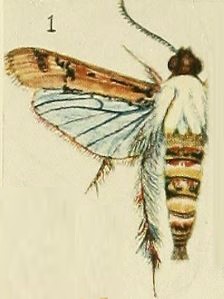
Psilogramma menephron, the privet hawk moth or large brown hawkmoth, is a member of the family Sphingidae. It was described by Pieter Cramer in 1780. It is usually found in Sri Lanka, India, Nepal, central and southern China, Thailand, Vietnam, Indonesia and the Philippines. Psilogramma casuarinae from eastern Australia was long treated as a synonym but is now thought to be a distinct species. The introduced population on Hawaii was first thought to be P. menephron, but is Psilogramma increta.

Daphnis hypothous, the jade hawkmoth, is a moth of the family Sphingidae described by Pieter Cramer in 1780. It is known from Sri Lanka, southern and northern India, Nepal, Myanmar, southern China, Taiwan, Thailand, Malaysia, and Indonesia. It is a rare vagrant to the Western Palaearctic realm. During the last hundred years a number have been discovered within the Middle East and one was even found in Scotland late in the 20th century but this was probably imported as a pupa with cargo.

Syntomoides imaon, the handmaiden moth, is a moth of subfamily Arctiinae, subtribe Ctenuchina. The systematics of the subfamily has been revised. It was described by Pieter Cramer in 1780. It is well distributed in Sikkim, Khasi hills and throughout India Kerala, Sri Lanka, Myanmar, Bangladesh and Hong Kong, Viet Nam.

Claterna is a monotypic moth genus of the family Noctuidae erected by Francis Walker in 1858. Its only species, Claterna cydonia, was first described by Pieter Cramer in 1775.

Metanastria is a genus of moths in the family Lasiocampidae described by Jacob Hübner in 1820. The species of this genus are found in Europe, Japan, China, South Africa, throughout India, Sri Lanka, Myanmar, Java and Borneo.

Hulodes caranea is a species of moth of the family Erebidae first described by Pieter Cramer in 1780. It is found from India, Sri Lanka, Myanmar, Java, Hong Kong to Queensland and New Guinea, it is also found on the Marianas and Carolines.

Dysphania is a genus of colourful moths in the family Geometridae and typical of the tribe Dysphaniini; they are sometimes called 'false tiger moths' and are found in northeast Australia, Melanesia, and south, east and southeast Asia.

Ercheia cyllaria is a species of moth of the family Erebidae first described by Pieter Cramer in 1779. It is found in the Indian subregion, Sri Lanka, Taiwan, Japan, Indochina, Thailand, Peninsular Malaysia, Sumatra, Borneo, Seram and the Kai Islands.

Trigonodes hyppasia, the triangles or semi-looper, is a moth in the family Erebidae. The species was first described by Pieter Cramer in 1779. It is largely cosmopolitan, found throughout Borneo, Fiji, India, Nepal, Sri Lanka, São Tomé and Príncipe, Taiwan, Zimbabwe, northern Australia, and almost all African countries.

Pergesa is a monotypic moth genus in the family Sphingidae first described by Francis Walker in 1856. Its only species, Pergesa acteus, the green pergesa hawkmoth, was described by Pieter Cramer in 1779.

Utetheisa lotrix, the salt-and-pepper moth or crotalaria moth, is a moth of the family Erebidae. The species was first described by Pieter Cramer in 1777. It is found in most of the Old World tropics.

Amplypterus panopus, the mango hawkmoth, is a moth of the family Sphingidae. The species was first described by Pieter Cramer in 1779. It is found in Sri Lanka, southern and northern India, Nepal, Myanmar, southern China, Thailand, Vietnam, Laos, Indonesia and the Philippines.

Melittia is a genus of moths in the family Sesiidae.

Aloa lactinea, the red costate tiger moth, is a moth of family Erebidae. The species was first described by Pieter Cramer in 1777. It is found in India, Japan, southern and western China, Taiwan, Java, Sumatra, Sri Lanka, Myanmar and the Philippines.

Lacera alope, the toothed drab, is a moth of the family Erebidae. The species was first described by Pieter Cramer in 1780. It is found in Africa, where it is known from southern and eastern Africa, including several islands of the Indian Ocean, Saudi Arabia, and southern Asia from India, Sri Lanka to China.

Eupterote fabia is a moth in the family Eupterotidae. It was described by Pieter Cramer in 1780. It is found in India, Sri Lanka and Bhutan.

Metanastria hyrtaca, called the hairy caterpillar as a larva, is a moth of the family Lasiocampidae first described by Pieter Cramer in 1782. It is found in Sri Lanka.

Gonodontis clelia is a moth in the family Geometridae first described by Pieter Cramer in 1780. It is found in Sri Lanka, South India, Pakistan, Nepal, Hong Kong, the Andaman Islands, Singapore, Borneo and Australia.

The Kandyan period covers the history of Sri Lanka from 1597–1815. After the fall of the Kingdom of Kotte, the Kandyan Kingdom was the last Independent monarchy of Sri Lanka. The Kingdom played a major role throughout the history of Sri Lanka. It was founded in 1476. The kingdom located in the central part of Sri Lanka managed to remain independent from both the Portuguese and Dutch rule who controlled coastal parts of Sri Lanka; however, it was colonised by the British in 1815.


















